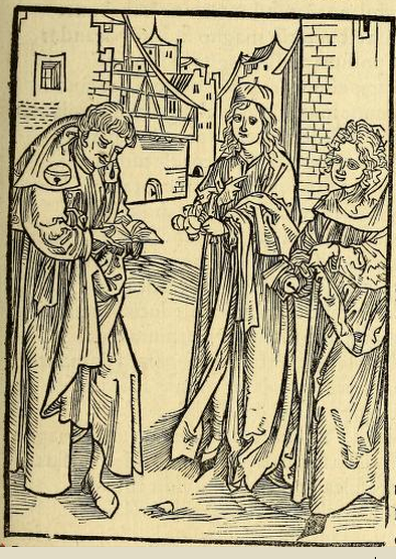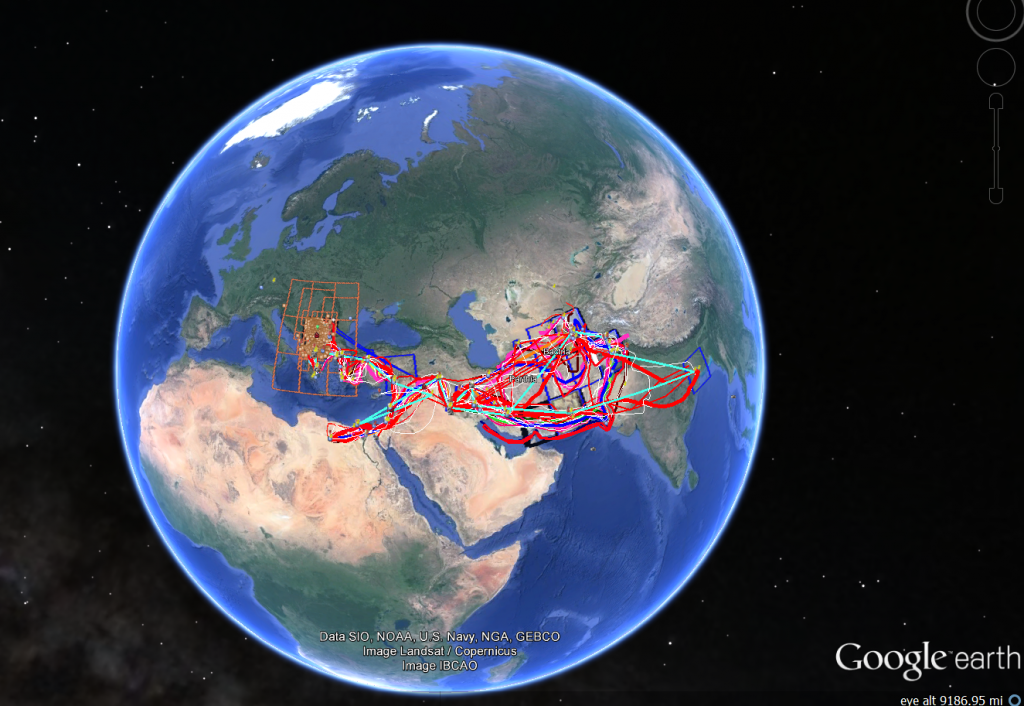The illustrated edition of Vergil’s works by German humanist Sebastian Brant and Strasbourg printer Johannes Grüninger from 1502 is an extraordinary example of early European book printing. In addition to the lavish and intricate illustrations, it contains the notes of five different people, none of whom is Brant himself, and who lived many centuries apart, from the 4th century scholar Servius to the near contemporary Italian humanist Cristoforo Landino. The notes contain information about history, religion, grammar, plants and medicine, rhetoric, contemporary vernacular poetry, and much else. The illustrations are best thought of as a visual translation and commentary on the text, distinct but related to the textual commentary. Brant’s Vergil is strikingly different from most commentaries of today, in which a single master scholar typically gives one synthetic perspective on the text. It is a diverse, highly collaborative, multimedia edition, and one that can provide a way to think about creating a collaborative, polyphonic, multimedia editions of the Aeneid in the digital realm.

Albrecht Dürer, Portrait of a Man (Sebastian Brant). 1520. Silver point drawing from the collection of the Berlin Kupferstichkabinett.
Sebastian Brant (1458–1521) was a noted German humanist, poet, legal scholar, anti-Reformation theologian, and author of one the classics of the genre of satire, Ship of Fools (Das Narrenshiff), which was first published in 1494 in Basel. Ship of Fools has been called the most important piece of German literature before Goethe’s The Sorrows of Young Werther. In the Latin translation of Jacob Locher (1497) it became the first book by a German author to have importance in European literature more generally. This portrait was made in Antwerp by Albrecht Dürer in 1520, by which time Brant was a senior figure in German letters. He was not, however, from a distinguished family. The son of an inn-keeper from Strasbourg, his father died when he was ten and he was raised mostly by his mother, born Barbara Picker.
In 1475, at the age of 17, Brant entered the recently founded University at Basel, where he studied philosophy initially, but quickly turned to law. He was teaching law there by 1486, both canon law and civil law, as well as humanities. Brant preferred the Roman-inspired civil law to ecclesiastically-based canon law, and was a lifelong supporter of the Holy Roman Empire, which he saw as a direct descendant of the Roman Empire. Allegiance to Emperor Maximilian and the Roman Church he saw as the only way of uniting Christendom in a hoped-for campaign to retake Constantinople and the Holy Land from the Turks.
During the late 1480s Brant became interested in the new medium of printing, and started to work as a publication expert and advisor for the Basel book printers, editing manuscripts, reading proof, writing introductions or prefaces, and composing what we would call “blurbs” in the form of dedicatory Latin verse soliciting readers’ interest in newly published books. At least one-third of all volumes printed in Basel before 1490 show signs of his collaboration. Latin verse composition was one of Brant’s particular talents, and his substantial collected works include equal amounts of Latin and German.

Anonymous, “Of Useless Books” (1494). Woodcut to accompany Sebastian Brant’s Ship of Fools, Latin edition, Basel 1498. University of Houston Libraries
This is a fool, the first in the gallery of a hundred or so in Brant’s most celebrated work.
If on this ship I’m number one
For special reasons that was done,
Yes, I’m the first one here you see
Because I like my library.
Of splendid books I own no end,
But few that I can comprehend.
Ship of Fools was produced with the help and financial aid of Brant’s friend the printer Johann Bergmann von Olpe of Westphalia, and it is a magnificent piece of book binding with some of the finest woodcuts of the fifteenth century.

Here is a folio from the Latin version of 1497, in an exemplar from the John Carter Library. Each type of fool gets an illustration, which itself has a verse caption. Then there is a prose summary, and then the main part of the poem, around 30-70 lines.
On the strength of the success of Narrenschiff Brant was a famous man when, in 1500, he left Basel and traveled back to his native city to enter in 1501 the status of Syndic of the City. In 1503 he became Stadtschreiber or chancellor, a position he held until his death in 1521. From this position he began a collaboration with the great Strasbourg printer Johannes Grüninger, and the two produced the first German translation of the Aeneid in 1515.

Title Page
Sebastian Brant, Publii Virgilii Maronis Opera cum quinque vulgatis commentariis expolitissimisque figuris atque imaginibus nuper per Sebastianum Brant superadditis. Strasbourg: Johannis Grieninger, 1502.
Universitätsbibliothek Heidelberg
But one of his first projects when he returned to Strasbourg was the great Latin edition of the works of Vergil which is my main subject today. It appeared in 1502, comprising 540 leaves, with 214 specially made woodcuts.
As the placement of too-many-books guy at the start of Das Narrenschiff might imply, Brant had strong views on education and literary life, and he wrote on the topic frequently. Brant’s critique of late Medieval education was the same one expressed by Lorenzo Valla, Erasmus, and others: the medieval grammarians bewitched their students with trivial and confusing logic chopping, teaching them to know nothing, or leaving them more foolish than when they arrived. In Ship of Fools he compares contemporary teachers to the Biblical plagues of Egypt. “Night and day they shout the wordy dogmas of logic, like the raucous croaking of frogs. With such enticements as these the young are violated (violatur prima iuventus), seeking nothing useful, nothing delightful.” (Stultitiae Navis [Basel 1497] 38 v). The solution, Brant perhaps felt, could be founds in Vergil. Here was a text both useful and delightful (Ūtile nīl quaerēns, nīl dēlectābile gustāns).

Anonymous, “Of Useless Learning.” 1494. Woodcut to accompany Sebastian Brant’s Ship of Fools. Latin edition, Basel 1498. John Carter Brown Library.
As the 15th c. Italian humanist Christoforo Landino argued in the preface to his seminal commentary on the works of Vergil, this poet, with his sublimely sweet, dignified style and superlative examples of character, “offers us the most when it comes both to speaking with gravity and eloquence, and to living well and happily.” Vergil was useful both as a manual of eloquence and a guide to life. When properly presented, Brant believed, Vergil could be the breath of fresh air that modern intellectual life required. In the printer Johannes Gruninger Brant found an ideal collaborator. Active in Strasbourg since 1482, he had developed his workshop into a leading producer of illustrated books, putting out at least 51 illustrated editions between 1485 and 1500. He had already produced annotated, illustrated editions of classical authors including Terence (1496), Horace (1498), and Boethius (1501).

The illustrations are intricate, and pay close attention not just to the details of the text itself, but also to scholarly material, in this case to the Life of Vergil by the ancient grammarian Donatus. The title page portrays Vergil being crowned by a Muse amidst various people important to his life and career, including the emperor Augustus, Cornelius Gallus, and Maecenas. There is generous treatment of landscape, which is typical of woodcuts in this period in Germany.

Vergil is seen in the background conversing another figure, evidently saying something about the horses which stand in front of them. A third figure comes in at the left, holding a basket. This derives from an apocryphal story told by Donatus, according to which Vergil as a young man was trained in veterinary medicine at Milan, and came to the attention of one of the stable keepers of Octavian living there. The stable keeper gave Vergil a daily ration of bread in return for veterinary consultations, and this allowance was doubled by Octavian when he learned of Vergil’s amazing skills at predicting the quality of horses.

Another notable feature of the engravings is their ignorance of ancient dress and building styles, and their pervasive anachronism in terms of furniture and physical environment. Here is the introductory woodcut for the Aeneid, which goes with the proem and the first twenty or so lines which explain the origins of Juno’s hostility to the Trojans. We see the judgment of Paris in the lower right, with Paris dressed as a contemporary Alsatian herdsman. At the left, Vergil addresses the Muse from a chair just like that of the too many books guy, but in this case the intent is not satirical. Rather it indicates that he is a scholar. The cityscapes are contemporary, as in the tradition of medieval manuscript illumination. This is Carthage from the same folio.

And here is how Paris is depicted in the famous illustrated book Liber chronicarum printed in Nurenburg in 1493, and you can see the same kind of towers and buildings.

Anonymous. 1495. Ship of Columbus. Woodcut to accompany. Historia Baetica. Cristoforo Colombo Epistola de insulis nuper inventis (Basel 1495). Beineke Library
Aeneas’ ships look for all the world like the Spanish galleons of Brant’s own day. In fact, close examination of Aeneas’ ships shows that the artists were aware of the recent publication of Columbus’ accounts of his voyage to the new world. Aeneas’ ships look like Columbus’ down to the smallest details. One could see this a mere plagiarism, or perhaps there is an effort to equate the voyages of discovery and colonization of these two explorers, one contemporary, one ancient.
How were the images created? In the dedicatory preface Brant takes credit for the making of the images (tabellas quas pinximus),
Quam nisi ut hās nostrās quās pinxerim, ecce, tabellās
Virgiliō chārās tu quoque habēre velīs, 50
hās tibi nēmo antehāc tam plānē ostenderat usquam,
nēmo tibī voluit pingere Virgilium.
nunc memorare potes monochromata cuncta Maronis
quam leviter pictīs, lector amice, locīs.
Please be willing to consider the pictures that I have painted here to be delightful additions to Vergil. No one has ever displayed these to you so clearly before, no one has been willing to paint Vergil for you. How easily, gentle reader, can you can now call all the monochromes of Vergil to mind, now that the passages have been illustrated! (Brant 1502, preface p. 7, my trans.)
But it is unlikely that Brant was actually doing the cutting of the blocks. Rather, evidence from Brant’s other collaborations in Basel suggests Brant provided design sketches and scholarly information, and the woodcuts were executed by the artists in Gruninger’s shop. As we have seen the attitude of the scholar is often apparent in the illustrations. They seem designed to capture the maximum amount of relevant information about the text.

Brant 1502. Exit from the Underworld. Woodcut to accompany
Vergil, Aeneid 6.854-901
In an image for Book 6, we see the famous final scene describing the death and funeral of young Marcellus, Augustus’ heir. In the center, Anchises finishes telling Aeneas and the Sibyl the future of Rome. In the lower center, Marcellus’ famous namesake M. Claudius Marcellus drives away a Gaul or a Carthaginian, as described by Vergil (855-9; sistet eques, sternet Poenos Gallumque rebellem 858); on the elder Marcellus’ shoulder hangs the spolia opima, the armor that an ancient Roman general stripped from the body of an opposing commander slain in single combat. Marcellus was the third and last to do this (tertiaque arma patri suspendet capta Quirino 859), a fact only obliquely alluded to by Vergil.
Young Marcellus, Augustus’s adopted son and heir, is shown on the left, below a funeral scene. In this scene, Augustus stands in regal attire pointing at a funeral bier, which has flowers scattered on it and a fire burning beneath it. A woman weeps at the bier, and other mourners gather behind the tomb. Vergil himself says nothing about Augustus, the funeral, a bier, or bystanders. He just has the narrator Anchises lament the lost potential of Marcellus, and urge all to bring flowers with full hands. The ancient commentator Servius, however, whose notes Brant includes in his edition, reports that public mourning for Marcellus was intense, and that Augustus ordered a funeral procession of 600 biers to enter the city and proceed to the Campus Martius, where Marcellus was interred with great ceremony (Serv. ad 8.61.)
To the right, Vergil, in the guise of a bard, sings to Marcellus’ mother Octavia, Augustus’ sister, whose importance is signified by a crown next to her. She holds the ashes of her son Marcellus. None of this is in the text. Once again it is Servius who reports, in a note on this passage, that Book 6 was once recited to Augustus and Octavia with such emotion that they would have ordered the performance to stop at this point, had not Vergil said that this was in fact the end. Servius explains that this whole passage was written to flatter Augustus, as an elegy to Marcellus (ergo modo in Augusti adulationem quasi epitaphion ei dicit). This explains the prominence of members of the imperial family in the image.
In the top right corner, the very final scene of the book is depicted: Anchises leads Aeneas and the Sibyl up from the underworld, out through the gates of Sleep, to the world above. Aeneas’s ship waits along the shore by the underworld’s exit (893-8).
So this is far from a straightforward illustration of the text, since it includes several things that do not actually occur in it, but which are found in Servius’ commentary, and which provide historical context that makes clear the importance of the scene.
Why did Brant and Grüninger spend so much time and money creating these elaborate woodcuts? Clues to their intent can be found in the introductory promotional poem. There Brant stresses the importance of visual art as a medium. He makes the argument that visual art should hold a valued place in the humanities, just as it did in ancient times, when important public figures were painters, and when important painters were publicly honored. He also speaks of expanding the audience for the poem beyond the highly learned scholars who were the audience for Aeneid editions hitherto. Aeneas himself, he points out, is nowhere said to have been learned, yet he fed his soul on images, such as the reliefs on the temple of Juno at Carthage. In a poem at the end of the volume it becomes even clearer that Brant envisioned the widest possible audience for the book:
Vergilium exponant aliī sermōne disertō.
Et calamō puerīs trādere et ore iuvent.
Pictura agrestī voluit Brant atque tabellīs
ēdere eum indoctīs rusticolīsque virīs.
Nec tamen abiectus labor hic, nec prorsus inānis.
Nam memorī servat mente figura librum.
Let others explain Vergil in eloquent speech and be pleased to teach him to boys in written and spoken form; Brant wished to publish him for unlearned and peasant folk in rustic pictures and drawings. Nevertheless, this task is neither lowly nor wholly useless, for the picture preserves the book in the remembering mind. (Brant 1502, appendix fol. 33 v., trans. Annabel Patterson)

Brant 1502. 212r. Vergil, Aeneid 4.65-76 with commentary
Illustration as a way to broaden the audience for a text was nothing new, of course. In fact Brant hearkens back to a medieval tradition of church art that was intended to make the stories of the Bible more memorable, an idea that is explicitly stated as early as Gregory the Great. And the illustrations for Ship of Fools were a significant part of its popular success. But in this case it is clear that the illustrations in no way substitute for the text. In fact it is not really possible to understand them without some knowledge of the text beforehand. And as we just saw they often encode scholarly knowledge that it not in the text at all. The images require explication just as much as the text does. Bernd Schneider is probably closer to the truth when he speaks of the images as a kind of visual translation of the text. I would call them translation and commentary on the text, since at times they bring in scholarly knowledge and historical context, and connect the text to the world of the reader. The mnemonic function is also clearly important.
The actual textual commentary of Brant’s Vergil edition is not original with Brant. He reprinted notes that already existed, such as those of Servius and Landino. But he did add his own verse summaries of the Aeneid at the head of every book. This shows that one of his main goals was to keep the reader oriented in the story—an important thing when one it reading slowly through a long text in Latin that might be only imperfectly understood, and something that these images can do very well.
It is important also to place the images in the content of the volume in which they are situated. Brant, as I mentioned, did not write notes, but included notes by the late antique commentators Servius and Donatus. These are primarily linguistic and antiquarian. He also included notes by Renaissance Italians Landino, Mancinelli, and Calderini. Landino’s preface, quoted earlier, makes clear the rhetorical perspective of these writers. Their notes often point out literary effect, tone, and the like. But they also treat Vergil as a kind of gateway to all kinds of knowledge, including astronomy, medicine, history, and other subjects. This approach is typical of Renaissance commentaries, and is seen in its most extreme for in the colossal Vergil commentary of La Cerda, which positively engulfs the text with encyclopedic learning. You can see what the commentary part of the book looked like in this translated excerpt of the notes for a single page, the passage in Book 4 where Dido is consulting diviners to try and deal with her love for Aeneas. Vergil famously compared her to a stag wounded by a Cretan hunter.

Brant 1502, translation of commentary at 212r.
Note especially the diversity of voices. Servius is telling you about declensions and conjugations, Landino is quoting Pliny on botany and medicine, and including a quotation from the love lyrics of Petrarch. This is a polyphonic commentary that uses all kinds of resources and scholarly and artistic voices to enrich the reading experience and to mediate between the world of the text and the world of the reader.
The commentaries that I and other contemporary classical students typically use are authored by a single scholar, usually one of many decades experience in teaching and research, such as the masterful Vergil editions of R.G. Austin, which I adored as a college student. But the Brant-Gruninger Vergil contains the notes of not one but 5 different people, none of whom is Brant himself, and who lived many centuries apart, from the 4th century scholar Servius to the near contemporary Italian humanist Landino. The notes contain snippets of information about history, religion, grammar, plants and medicine, rhetoric, contemporary vernacular poetry, and much else. Then there are the illustrations: lavish, detailed, intriguing, seemingly separate from the notes but actually enmeshed with them and offering a totally different kind of window into the world of the text. In short, Brant’s Vergil is a diverse, highly collaborative, multimedia edition, and one that, it seems to me, can provide a way to think about creating a collaborative, polyphonic, multimedia edition of the Aeneid in the digital realm, one quite different from the standard print commentaries of today, where a single scholar controls the discourse exclusively.
Bibliography
Brant’s Ship of Fools (1494)
Brant, Sebastian. Sebastian Brands Niv-Schiff von Narragonien [Das Narrenschiff]. Basel: [Johann Bergmann], 1494. The editio princeps. An exemplar at the Darmstadt University library has been well photographed: http://tudigit.ulb.tu-darmstadt.de/show/inc-ii-218
Brant, Sebastian, and Jakob Locher. Stultifera Navis. Basel: Bergman de Olpe, 1497. Free Latin verse translation of Das Narrenschiff, made by Locher under the general supervision of Brant. Two exemplars from the John Carter Library have been well photographed. A printing from 1572 has been fully transcribed and digitally edited by a team at the University of Mannheim: http://www.uni-mannheim.de/mateo/camena/locher2/lochernavis.html
Brant, Sebastian. The Ship of Fools, translated into rhyming couplets with introduction and commentary by Edwin H. Zeydel, with reproductions of the original woodcuts. New York: Columbia University Press, 1944 (repr. Dover 1962). Free, rhyming trans. into English from the German version. Excellent introduction, and passable reproductions of the woodcuts.
Modern Scholarship:
Kallendorf, Craig. “The Aeneid Transformed: Illustration as Interpretation from the Renaissance to the Present,” in Sarah Spence, ed., Poets and Critics Read Vergil (New Haven: Yale Uiversity Press, 2001), 121–148. A good analytical survey. Kallendorf is the key scholar in this area writing in English.
Kallendorf, Craig. “Vergil and Printed Books, 1500–1800,” in Joseph Farrell and Michael Putnam, eds., A Companion to Vergil’s Aeneid and Its Tradition (Malden, MA: Wiley Blackwell, 2014), 234–250. Well-informed discussion of various types of early modern reading practices.
Raab, Theodore K. “Sebastian Brant and the First Illustrated Edition of Vergil,” The Princeton Library Chronicle 21 (1960), 186–199.
Schneider, Bernd. “’Virgilius Pictus’—Sebastian Brants illustrierte Vergilausgabe von 1502 und ihre Nachwirkug: Ein Beitrag zur Vergilrezeption im deutschen Humanismus.” Wolfenbutteler Beiträge 6 (1983), 202–262. Excellent analysis. Key for understanding Brant’s role in the creation of the illustrations.
Suerbaum, Werner. Handbuch der illustrierten Vergil-Ausgaben, 1502–1840. Hildesheim: Georg Olms, 2008. The comprehensive catalogue and bibliography.
Wilhelmi, Thomas. Sebastian Brant: Kleine Texte. 2 vols. Stuttgart-Bad Cannstatt: Günther Holzboog, 1998. Good modern edition of all the minor works.
Winsor Leach, Eleanor. “Illustration as Interpretation in Brant’s and Dryden’s Editions of Vergil,” in Sandra Hindman, ed., The Early Illustrated Book: Essays in Honor of Lessing J. Rosenwald (Washington, DC: Library of Congress, 1982), 175–210.




























